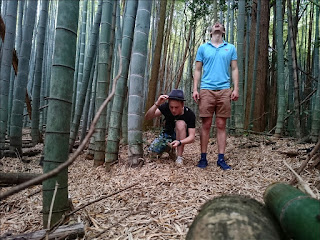While I'm writing this post we're having a good time sitting around a table in the community room of our youth hostel in Amanohashidate chatting with two French and an English student - so please forgive me if I sound a little distracted ;-).
Our three days in Kyoto were very eventful and passed extremely quickly. We felt a little dazed by the overwhelming amount of ancient temples and shrines, beautiful gardens and parks and quaint old towns.
As it is impossible to see everything in the short time we spent there, we tried our best to pick the most worth seeing places.
One of those places is the Kiyomizu-dera, which we visited on our first day in Kyoto and is mentioned in rhe prior post. I have recently updated it with some interesting facts, so go and check it out!
The probably most famous site in Kyoto is the Kinkaku, also known as the Golden Pavilion. The Kinkaku is a shariden, a Buddhist hall containing relics of Buddha and dating back to 1937.
The pavilion is part of a temple that is formally named Rokuon-Ji Temple, but commonly called Kinkaku-Ji Temple.
It originally used to be a villa called Kitayama-dai, owned by the statesman Saionji Kintsune and later aquired by the shogun Ashikaga Yoshimitsu.
After his death and keeping with his will, the villa was converted into a temple by the priest Muso-kokushi.
The temple's name, Rokuon-Ji, was derived from the name Yoshimitsu was given for the next world, Rokuon-in-den.
The pavilion is part of a temple that is formally named Rokuon-Ji Temple, but commonly called Kinkaku-Ji Temple.
It originally used to be a villa called Kitayama-dai, owned by the statesman Saionji Kintsune and later aquired by the shogun Ashikaga Yoshimitsu.
After his death and keeping with his will, the villa was converted into a temple by the priest Muso-kokushi.
The temple's name, Rokuon-Ji, was derived from the name Yoshimitsu was given for the next world, Rokuon-in-den.
 |
| Gold foil on laquer covers the two upper levels of the Kinkaku, and a shining phoenix stands on top of the roof. |
One other site that impressed me even more than Kinkaku was the Sanjusangen-do Temple.
It contains a gigantic seated statue of the Buddhist deity Kannon, an incredible 1000 (!!!) smaller, life-size represantations of her and another 28 statues of guardian deities.The guardian deities are supposed to protect Kannon as well as pious Bhuddhists who believe in Kannon. Many of them have their origin in India. Among the 1000 Kannon statues 124 were made in the 12th century when the temple was founded and the remaining 876 in the 13th century when the temple was renovated after a fire.
We are quickly getting used to not being allowed to take any pictures inside of temples. Here is one I found on the internet:
Our personal highlight in Kyoto however was none of the aforementioned, but the Fushimi Inari Taisha, a Shinto Shrine dedicated to Inari, the god of rice and the patron of business. It sits on top of a mountain called Inari, which is 233 metres above sea level. There are several paths leading to the top, which are highlighted by Torii gates.
As we found out on our way back however, there are also other, wilder and more hidden paths, which guide you through dense forests, steep hills and bamboo.
Although the directions we had been given by some Englishmen were quite loose and frowsy we didn't get lost too badly and found our way to the next train station quickly enough.
It was a small adventure that we highly enjoyed and will remember fondly.









Like your photo's here .Beautiful shot if the lake and also the bamboo forest .
ReplyDeleteWhere were the Panda's?